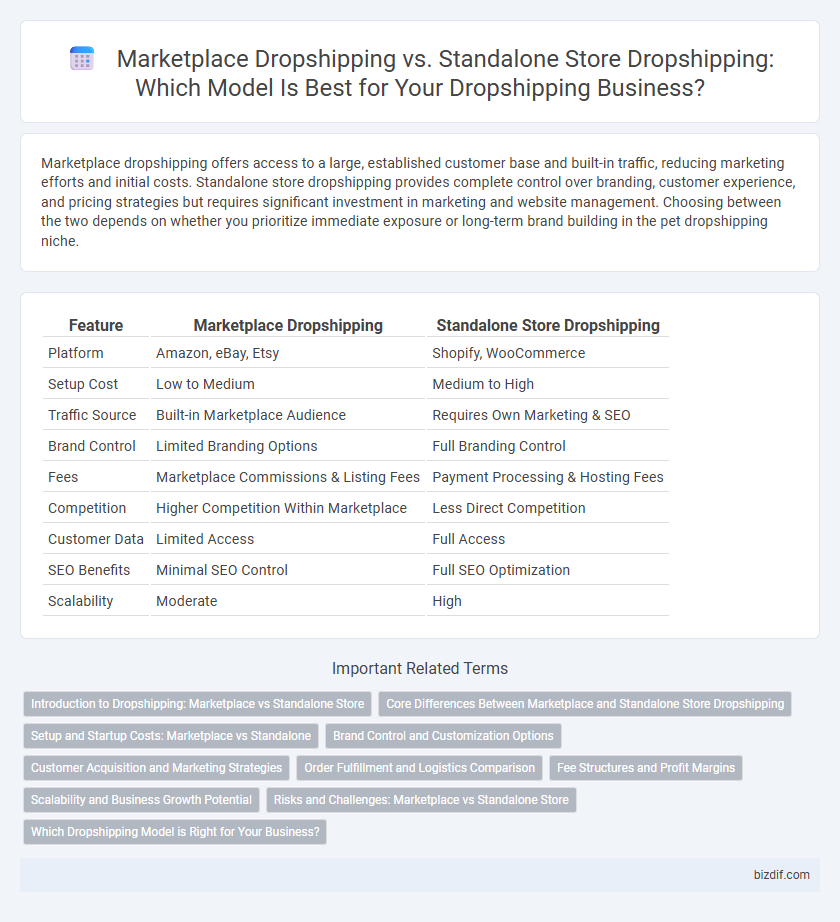Marketplace dropshipping offers access to a large, established customer base and built-in traffic, reducing marketing efforts and initial costs. Standalone store dropshipping provides complete control over branding, customer experience, and pricing strategies but requires significant investment in marketing and website management. Choosing between the two depends on whether you prioritize immediate exposure or long-term brand building in the pet dropshipping niche.
Table of Comparison
| Feature | Marketplace Dropshipping | Standalone Store Dropshipping |
|---|---|---|
| Platform | Amazon, eBay, Etsy | Shopify, WooCommerce |
| Setup Cost | Low to Medium | Medium to High |
| Traffic Source | Built-in Marketplace Audience | Requires Own Marketing & SEO |
| Brand Control | Limited Branding Options | Full Branding Control |
| Fees | Marketplace Commissions & Listing Fees | Payment Processing & Hosting Fees |
| Competition | Higher Competition Within Marketplace | Less Direct Competition |
| Customer Data | Limited Access | Full Access |
| SEO Benefits | Minimal SEO Control | Full SEO Optimization |
| Scalability | Moderate | High |
Introduction to Dropshipping: Marketplace vs Standalone Store
Marketplace dropshipping leverages established platforms like Amazon or eBay, offering immediate access to a large customer base and simplified payment processing, but often involves higher competition and platform fees. Standalone store dropshipping requires building an independent e-commerce website using tools like Shopify or WooCommerce, providing full brand control and marketing flexibility while demanding more effort in customer acquisition and site management. Both models depend on supplier reliability and efficient order fulfillment to succeed in the competitive dropshipping landscape.
Core Differences Between Marketplace and Standalone Store Dropshipping
Marketplace dropshipping leverages established platforms like Amazon or eBay, offering immediate access to large customer bases and built-in traffic, but it comes with higher competition and platform fees. Standalone store dropshipping requires creating a unique e-commerce website, providing full control over branding, customer experience, and profit margins, yet demands significant marketing efforts to drive traffic independently. Key differences include control over sales channels, marketing responsibility, brand identity, and associated costs, influencing business scalability and operational autonomy.
Setup and Startup Costs: Marketplace vs Standalone
Marketplace dropshipping requires minimal startup costs and a streamlined setup process, as sellers leverage existing platforms like Amazon or eBay that provide integrated payment systems and traffic. Standalone store dropshipping demands higher initial investments in website development, hosting, and marketing tools, creating a customizable but cost-intensive infrastructure. Choosing marketplace dropshipping reduces financial risks, while standalone stores offer greater control and branding opportunities despite elevated upfront expenses.
Brand Control and Customization Options
Marketplace dropshipping offers limited brand control and customization options due to standardized platform designs and policies, restricting unique customer experiences. Standalone store dropshipping provides full brand control and flexible customization, enabling tailored website design, personalized marketing, and distinct brand identity. This control enhances customer loyalty and competitive differentiation in the dropshipping business model.
Customer Acquisition and Marketing Strategies
Marketplace dropshipping leverages built-in customer traffic from platforms like Amazon or eBay, reducing the need for extensive marketing efforts but increasing competition and reliance on platform policies. Standalone store dropshipping demands robust customer acquisition strategies through targeted digital marketing channels such as SEO, PPC, and social media advertising to drive traffic and build brand loyalty. Effective marketing for standalone stores often involves personalized content, email campaigns, and retargeting techniques to optimize conversion rates and customer retention.
Order Fulfillment and Logistics Comparison
Marketplace dropshipping often benefits from integrated order fulfillment systems and established logistics networks, enabling faster shipping and streamlined tracking. Standalone store dropshipping requires merchants to manage order processing and coordinate with suppliers directly, which can introduce variability in delivery times and customer service quality. Efficient logistics in marketplace dropshipping generally result in higher customer satisfaction due to reliable order tracking and standardized shipping procedures.
Fee Structures and Profit Margins
Marketplace dropshipping typically involves fees such as listing charges, transaction commissions, and payment processing costs, which can reduce overall profit margins but offer higher traffic and customer trust. Standalone store dropshipping incurs costs related to web hosting, marketing, and payment gateways but allows greater control over pricing strategies and potentially higher profit margins due to eliminated marketplace commissions. Evaluating fee structures against expected sales volume is crucial for maximizing profitability in either marketplace or standalone dropshipping models.
Scalability and Business Growth Potential
Marketplace dropshipping offers easier access to large customer bases, enabling faster initial sales but limits scalability due to platform fees and restricted branding opportunities. Standalone store dropshipping provides greater control over brand identity, customer experience, and marketing strategies, which enhances long-term business growth potential despite slower initial traction. Investing in SEO, custom marketing, and customer retention on standalone stores significantly increases scalability and sustainable revenue streams.
Risks and Challenges: Marketplace vs Standalone Store
Marketplace dropshipping faces risks such as intense competition, limited brand control, and reliance on platform policies that can abruptly change, impacting seller visibility and account stability. Standalone store dropshipping encounters challenges including higher customer acquisition costs, the need for robust website management, and increased responsibility for marketing, fulfillment, and customer service. Both models must navigate inventory synchronization issues, supplier reliability concerns, and potential cash flow disruptions.
Which Dropshipping Model is Right for Your Business?
Marketplace dropshipping leverages established platforms like Amazon or eBay to access a vast customer base with lower initial marketing costs but faces high competition and platform fees. Standalone store dropshipping offers full brand control, customizable customer experience, and greater profit margins, requiring effective marketing strategies and initial investment in website development. Choosing the right model depends on your business goals, budget, and willingness to manage marketing and customer service independently.
Marketplace Dropshipping vs Standalone Store Dropshipping Infographic

 bizdif.com
bizdif.com